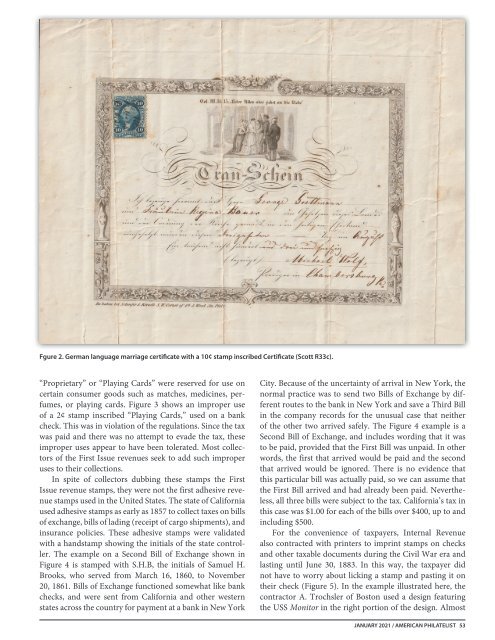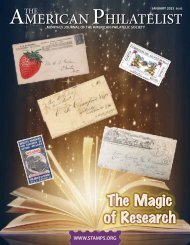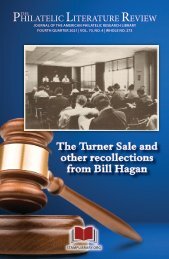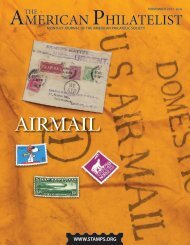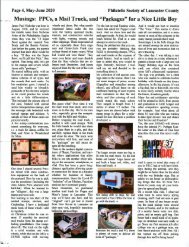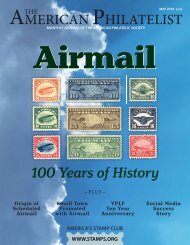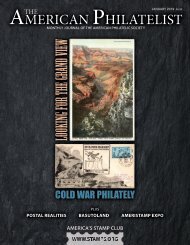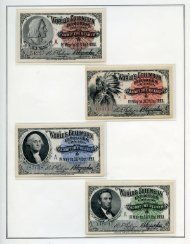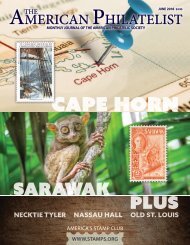221JANAP_web
Create successful ePaper yourself
Turn your PDF publications into a flip-book with our unique Google optimized e-Paper software.
Fgure 2. German language marriage certificate with a 10¢ stamp inscribed Certificate (Scott R33c).<br />
“Proprietary” or “Playing Cards” were reserved for use on<br />
certain consumer goods such as matches, medicines, perfumes,<br />
or playing cards. Figure 3 shows an improper use<br />
of a 2¢ stamp inscribed “Playing Cards,” used on a bank<br />
check. This was in violation of the regulations. Since the tax<br />
was paid and there was no attempt to evade the tax, these<br />
improper uses appear to have been tolerated. Most collectors<br />
of the First Issue revenues seek to add such improper<br />
uses to their collections.<br />
In spite of collectors dubbing these stamps the First<br />
Issue revenue stamps, they were not the first adhesive revenue<br />
stamps used in the United States. The state of California<br />
used adhesive stamps as early as 1857 to collect taxes on bills<br />
of exchange, bills of lading (receipt of cargo shipments), and<br />
insurance policies. These adhesive stamps were validated<br />
with a handstamp showing the initials of the state controller.<br />
The example on a Second Bill of Exchange shown in<br />
Figure 4 is stamped with S.H.B, the initials of Samuel H.<br />
Brooks, who served from March 16, 1860, to November<br />
20, 1861. Bills of Exchange functioned somewhat like bank<br />
checks, and were sent from California and other western<br />
states across the country for payment at a bank in New York<br />
City. Because of the uncertainty of arrival in New York, the<br />
normal practice was to send two Bills of Exchange by different<br />
routes to the bank in New York and save a Third Bill<br />
in the company records for the unusual case that neither<br />
of the other two arrived safely. The Figure 4 example is a<br />
Second Bill of Exchange, and includes wording that it was<br />
to be paid, provided that the First Bill was unpaid. In other<br />
words, the first that arrived would be paid and the second<br />
that arrived would be ignored. There is no evidence that<br />
this particular bill was actually paid, so we can assume that<br />
the First Bill arrived and had already been paid. Nevertheless,<br />
all three bills were subject to the tax. California’s tax in<br />
this case was $1.00 for each of the bills over $400, up to and<br />
including $500.<br />
For the convenience of taxpayers, Internal Revenue<br />
also contracted with printers to imprint stamps on checks<br />
and other taxable documents during the Civil War era and<br />
lasting until June 30, 1883. In this way, the taxpayer did<br />
not have to worry about licking a stamp and pasting it on<br />
their check (Figure 5). In the example illustrated here, the<br />
contractor A. Trochsler of Boston used a design featuring<br />
the USS Monitor in the right portion of the design. Almost<br />
JANUARY 2021 / AMERICAN PHILATELIST 53


